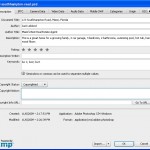 It’s Saturday morning, so you know what that means – time for another SEO Tip. This week’s tip is so simple some of you may wonder if it’s even true, others may wonder why they haven’t been doing it already.
It’s Saturday morning, so you know what that means – time for another SEO Tip. This week’s tip is so simple some of you may wonder if it’s even true, others may wonder why they haven’t been doing it already.
You have all been told for years that you must add lots and lots of images to your sites. You’ve learned that visitors enjoy looking at pictures of houses, that blog readers are pulled in by having large images at the top of a post.
But is it possible to bring more traffic in from the search engines because of how you use images on your sites? The answer is yes. Today we’ll cover a few ways to help your site rank better using images.
Before we continue, take six minutes and watch these three Google Webmaster videos:
- Should I expect increased traffic if I optimize my images?
- Matt Cutts Discusses the Importance of alt Tags
- Does Google consider the URL of an image?
That pretty well sums up this post…oh, you want more? Fine, keep reading.
Use Descriptive File Names for Images
In video 1, Matt flat out tells us – YES OPTIMIZING IMAGES WILL INCREASE TRAFFIC. What else do I need to say to convince you?
Matt suggests using descriptive file names for your images. Don’t keep the bland,boring name your camera created, what good is a name like “dsc00234.jpg”? You should use a carefully thought out descriptive name. You shouldn’t get too carried away with long file names, but I do suggest using multiple words. Of course, keep in mind our tip from last week and use dashes to separate the words in your file name. Possibly use something like: “3576-lakeview-street-homerville-tennessee-kitchen-1.jpg”.
Use ALT Tags for Images
In Video 2, Matt reinforces something I and others have already told you – ALT tags for your images are important. However, he does tell us something new; it’s OK to use slightly longer, more descriptive text instead of just “cat”, “house” or “motorcycle.” So what does that mean for you? It means that when you take pictures of a house you are listing, you have an opportunity to really do a good job of describing the property through photos, in a way the search engines not only understand, they want. Consider putting something like this in your ALT tags: “123 brookehaven road, Jasper, Wyoming – master bedroom – MLS 123456”. Be creative in your description, use words people will be using when they search the web.
Image File URLs
 In video 3, Matt reminds us that the URLs of files help the search engines figure out what is in the picture. Depending on how your site is constructed, this might take a little bit of planning. Rather than just drop all you images in a generic folder named “images”, or named for the date you uploaded them (like WordPress does by default), perhaps you should consider creating a special structure to store them in. You could get pretty detailed if you wanted to take the time. You may want to create a folder structure like what’s shown here, based on your state, county & city names. Of course, YOU should know your web traffic better than I do, use names you KNOW people use in searches, based on your keyword research.
In video 3, Matt reminds us that the URLs of files help the search engines figure out what is in the picture. Depending on how your site is constructed, this might take a little bit of planning. Rather than just drop all you images in a generic folder named “images”, or named for the date you uploaded them (like WordPress does by default), perhaps you should consider creating a special structure to store them in. You could get pretty detailed if you wanted to take the time. You may want to create a folder structure like what’s shown here, based on your state, county & city names. Of course, YOU should know your web traffic better than I do, use names you KNOW people use in searches, based on your keyword research.
BONUS Information
How well did you listen to video 3? Go back and listen to it again, starting from about the 25 second mark, ending at about the 40 second mark. OCR and Meta-data for the images? Now we’re talking.
OCR?
 OCR, if you don’t know, stands for Optical Character Recognition. Matt’s comment implies that Google is able to READ and understand the text with in your images. How can you use this? Start adding a crisp, clear title to all of your images. Make it easy for them, place the text on a plain background and use a simple, non-swirly font.
OCR, if you don’t know, stands for Optical Character Recognition. Matt’s comment implies that Google is able to READ and understand the text with in your images. How can you use this? Start adding a crisp, clear title to all of your images. Make it easy for them, place the text on a plain background and use a simple, non-swirly font.
Meta-data?
 OMG! Not more meta tags! Take a deep breath, relax. It’s not more geeky tags. Image meta-data is often added automatically by digital cameras and it can be edited by many image editing tools to add all sorts of information. The image to the right is a screen shot taken from within Adobe Photoshop, but the software that came with your camera may also allow you to edit your files like this. Place your descriptive text within these fields before you upload them.
OMG! Not more meta tags! Take a deep breath, relax. It’s not more geeky tags. Image meta-data is often added automatically by digital cameras and it can be edited by many image editing tools to add all sorts of information. The image to the right is a screen shot taken from within Adobe Photoshop, but the software that came with your camera may also allow you to edit your files like this. Place your descriptive text within these fields before you upload them.
I know this was a lot of information, but I’m confidant you can manage it.
When working with images, keep the fortune cookie in mind; how it looks on the outside is important, but sometimes it’s what you can’t see that is more important.
Jack Leblond is a SEO/SEM professional working for a large corporation full time in Austin, TX. He is not a Realtor, he is our in-house SEO expert. Jack is the Director of Internet Strategy and Operations for TG (www.tgslc.org). In addition to managing the team that develops and maintains the company's multiple Web sites, he focuses on Search Engine Optimization (SEO), e-marketing and Social Media. Jack's background ranges from Submarine Sonar Technician/Instructor for the United States Navy, technical writer, pioneer in internet/intranet creation for McGraw-Hill and Times Mirror Higher Education, former Adjunct Professor for two Universities teaching web-related courses, has served as a city council member and co-founded Net-Smart, a web design and hosting company, where he managed networks and oversaw the development of hundreds of Web sites. As a free-lance SEO consultant, Jack performs SEO Site Audits for small/medium businesses that want their web sites to perform better in the search engine listings.










































Matt Stigliano
November 7, 2009 at 9:34 am
Jack – The OCR bit is news to me. That could be potentially pretty powerful (try to say that three times fast) and I had never thought of it. I’ve been using your dash vs. underscore theory lately and I immediately starting trying it on images.
Thanks for the constant supply of things to think about.
Hey, did you ever get my email about Google Analytics?
Ben Goheen
November 7, 2009 at 9:51 am
I’m with Matt here – had no idea the OCR thing was possible. Guess I should stop using Comic Sans for my preferred font. 🙂
I’d suggest probably not using “123 Any Street” or “MLS 13456” in the description. Besides the homeowner, not many people search for a home that way.
Another great SEO article – thanks Jack!
Rob McCance
November 7, 2009 at 8:17 pm
Good post.
Jack Allen
November 8, 2009 at 5:35 am
Excellent article, Jack. I had been using the meta data on my images for copyright use, but had never considered using descriptive text to help with search engine rankings. Thanks for the tip!
SteveBeam
November 8, 2009 at 12:29 pm
Sweet- I’ll check out the videos when I don’t have 4 kids under foot. I love video and can already see it driving large amounts of traffic to my site.
Vicki Moore
November 9, 2009 at 11:57 pm
I really appreciate the tips in small bites. I just tried to read an SEO 101 post. I got halfway through the first paragraph and CLICK – I’m gone!
Frampton Team
January 13, 2010 at 12:34 am
Nice article, but I have a flip side to consider: You say optimizing images would increase traffic, but how commercial-bound do you think image searchers really are? I’m not interested in just more traffic; rather, I’m interested in traffic that wants to buy a home.
I think it is conceivable that home buyers looking for a certain characteristic in a home may very well end up turning to Google Image Search; however, from looking at referrer reports a clear trend has been evident in my experience that most Google Image searchers are more intent on finding pictures to post on their blogs. Not everyone is thrilled to learn that some unreachable person has used a picture of their newly purchased home like a stock photograph on his/her blog. It’s for this reason that I have not only blocked hotlinking, but also went so far as to deny the image directory for home listings in my robots.txt file.
– Ken Schweickert
Programmer for the Frampton Team at RE/MAX Lafayette Group
Jack Leblond
January 13, 2010 at 9:28 am
Ken,
You’ve missed the point and shot the Frampton Team in their collective feet – twice.
The goal of optimizing images is NOT so you’ll be found in an image search. I can’t imagine anybody looking for a home that way. The primary goal is to build your relevance and authority on the main Google search. Secondarily, if one of your images applies to the search phrase, it will be displayed on the main page, within the consolidated results – that’s like striking oil. If you can get both a web result and an image result to show up at the same time, you have a very high likelihood of getting that persons traffic. By blocking Google from your images you have guaranteed that you r site will NEVER appear with consolidated results. There’s the first shot.
Unless the photo-links back to your site are eating into your bandwdth, they actually a good thing. Search engines, especially Google, LOVE links. Each one of those new homeowners you block is another link that Google could have followed back to your site. There’s the second shot.
I hope this clears some things up for you – hope your feet heal up OK.
Frampton Team
January 13, 2010 at 5:35 pm
Jack,
Thank you for the reply.
I should have been more specific in describing what I found from the referrer reports. These bloggers are not using the image *and* linking back to the site; they are simply setting the src attribute to the remote image. When a browser comes to download that image it includes the page where the image is located in the header as the referrer, but the user never actually realizes he/she made a connection to the site. As far as I have been able to tell, this yields no gain in authority to the site as a real link would (maybe because an image cannot spread out its Page Rank through links to other pages on the site?), but does help just that image rank in image results (and consequently consolidated results, as you mentioned). Perhaps you have evidence to the contrary?
The lack of presence in consolidated results is a true shot in the foot, yes. However, it is a calculated one, as a trade off by valuing quality of service (by protecting those who don’t want their homes blogged about for whatever reason) over quantity (number of clients for whom that service is performed). Better to be shot in the foot than in the head.
I believe I have made the right choice here, but I am certainly not an SEO, so I am quite open to suggestions.
– Ken
mooersrealty
November 21, 2010 at 6:25 pm
Images interesting, local and tagged right help beyond the copy. Video coming up in page one searches with the little player embed is cool too. Video is 30 frames per second and the audio is 40% of the video experience, delivery. Great post.